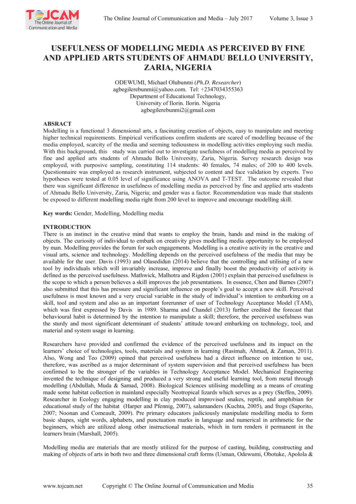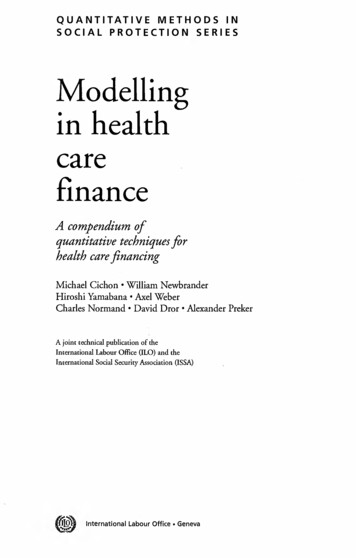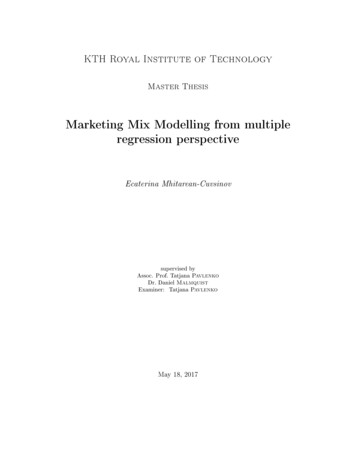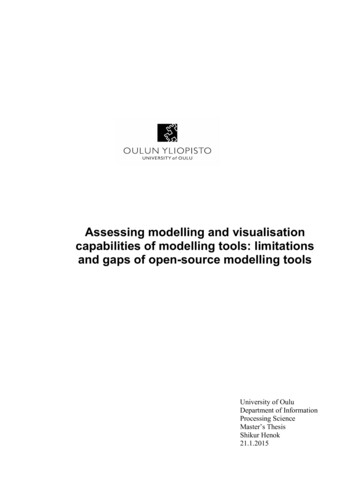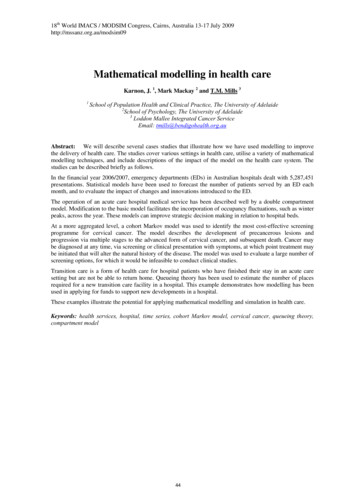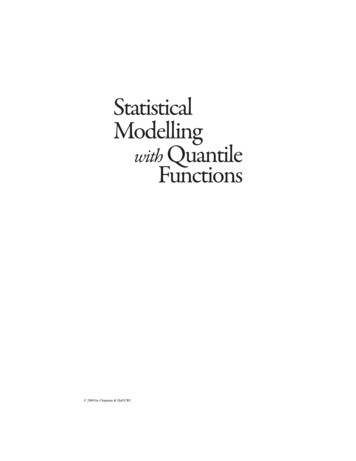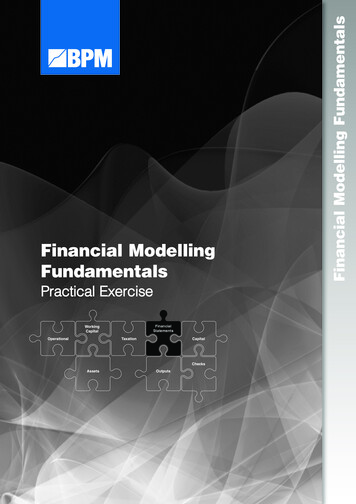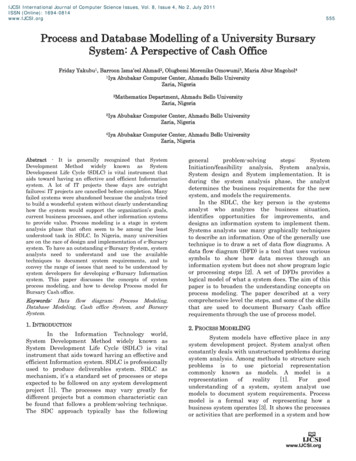
Transcription
IJCSI International Journal of Computer Science Issues, Vol. 8, Issue 4, No 2, July 2011ISSN (Online): 1694-0814www.IJCSI.org555Process and Database Modelling of a University BursarySystem: A Perspective of Cash OfficeFriday Yakubu1, Barroon Isma’eel Ahmad2, Olugbemi Morenike Omowumi3, Maria Abur Mngohol41Iya Abubakar Computer Center, Ahmadu Bello UniversityZaria, Nigeria2MathematicsDepartment, Ahmadu Bello UniversityZaria, Nigeria3IyaAbubakar Computer Center, Ahmadu Bello UniversityZaria, Nigeria4IyaAbubakar Computer Center, Ahmadu Bello UniversityZaria, NigeriaAbstract - It is generally recognized that SystemDevelopment Method widely known as SystemDevelopment Life Cycle (SDLC) is vital instrument thataids toward having an effective and efficient Informationsystem. A lot of IT projects these days are outrightfailures; IT projects are cancelled before completion. Manyfailed systems were abandoned because the analysts triedto build a wonderful system without clearly understandinghow the system would support the organization’s goals,current business processes, and other information systemsto provide value. Process modeling is a stage in systemanalysis phase that often seem to be among the leastunderstood task in SDLC. In Nigeria, many universitiesare on the race of design and implementation of e-Bursarysystem. To have an outstanding e-Bursary System, systemanalysts need to understand and use the availabletechniques to document system requirements, and toconvey the range of issues that need to be understood bysystem developers for developing e-Bursary Informationsystem. This paper discusses the concepts of systemprocess modeling, and how to develop Process model forBursary Cash office.Keywords: Data flow diagram; Process Modeling,Database Modeling, Cash office System, and BursarySystem.1. INTRODUCTIONIn the Information Technology world,System Development Method widely known asSystem Development Life Cycle (SDLC) is vitalinstrument that aids toward having an effective andefficient Information system. SDLC is professionallyused to produce deliverables system. SDLC asmechanism, it’s a standard set of processes or stepsexpected to be followed on any system developmentproject [1]. The processes may vary greatly fordifferent projects but a common characteristic canbe found that follows a problem-solving technique.The SDC approach typically has the ion/feasibility analysis, System analysis,System design and System implementation. It isduring the system analysis phase, the analystdetermines the business requirements for the newsystem, and models the requirements.In the SDLC, the key person is the systemsanalyst who analyzes the business situation,identifies opportunities for improvements, anddesigns an information system to implement them.Systems analysts use many graphically techniquesto describe an information. One of the generally usetechnique is to draw a set of data flow diagrams. Adata flow diagram (DFD) is a tool that uses varioussymbols to show how data moves through aninformation system but does not show program logicor processing steps [2]. A set of DFDs provides alogical model of what a system does. The aim of thispaper is to broaden the understanding concepts onprocess modeling. The paper described at a verycomprehensive level the steps, and some of the skillsthat are used to document Bursary Cash officerequirements through the use of process model.2. PROCESS MODELINGSystem models have effective place in anysystem development project. System analyst oftenconstantly deals with unstructured problems duringsystem analysis. Among methods to structure suchproblems is to use pictorial representationcommonly known as models. A model is arepresentationofreality[1].Forgoodunderstanding of a system, system analyst usemodels to document system requirements. Processmodel is a formal way of representing how abusiness system operates [3]. It shows the processesor activities that are performed in a system and how
IJCSI International Journal of Computer Science Issues, Vol. 8, Issue 4, No 2, July 2011ISSN (Online): 1694-0814www.IJCSI.orgdata moves. In order to illustrate a process model,data flow diagram is needed. DFDs revealrelationships among and between the variouscomponents in a system.Data flow diagram symbols consist of foursymbols which are processes, data flows, data storesand external entities. A process is an activity or afunction that is performed for some specific businessreason; A data flow is a single piece of data or alogical collection of several pieces of information; Adata store is a collection of data that is stored insome way; An external entity is a person,organization, or system that is external to thesystem but interact with it [4]. Figure 1, shows thestandard set of symbols that shall be used in thispaper.External EntityProcessData FlowData storeFigure 1: DFD set of symbolsWhen it comes to conveying how data flowsthrough system and how that data is transformed into the process, DFDs are the method of choice overtechnical descriptions for three principle reasons [4].1. DFDs are easier to understand by technicaland non-technical audiences2. DFDs can provide a high level systemoverview, complete with boundaries andconnections to other systems3. DFDs can provide a detailed representationof system n process modeling, the highest-level ofdata flow diagram is known as the context diagram[1]. A context diagram is a data flow diagram of anorganizational system that shows the systemboundaries, external entities that interact with thesystem and the major information flows between theentities and the system [5]. The context diagramshows the overall business process as just one556process and shows the data flows to and fromexternal entities. The context diagram is furtherdecomposed into the lower-level, and each processon the level can be decomposed into more explicitdata flow diagram. To properly model a systemusing DFDs there is a set of rules [8] that must befollowed:Rules of data flow diagrams: At least one input or output data flow forexternal entity At least one input data flow and/or at least oneoutput data flow for a process Output data flows usually have differentnames than input data flows for a process Data flows only in one direction Every data flow connects to at least one processRules of unique name in data flow diagrams: A unique name (verb phase), a number and adescription for a process A unique name that is a noun and a descriptionfor a data flow A unique name that is a noun and a descriptionfor data store A unique name that is a noun and a descriptionfor external entityRules of Consistency and Consistency Viewpoint: Every set of data flow diagrams must have onecontext diagram. There is a consistency viewpoint for the entireset of DFDs.Rules of Decomposition and Balancing Every process is wholly and completelydescribed by the processes on its children DFDs. Every data flow, data store and external entityon a higher level DFD is shown on the lowerlevel DFD that decomposes it.Rules of Data Store For every data store, data cannot move directlyfrom one data store to another data store. Data must be moved by a process.There are two primary types of problemsassociated with process modeling using DFDs:syntax errors and semantics errors. Syntax of thedata flow diagram refers to how components areinterconnected through data flows and whatcomponents constitute the subsystem beingmodeled, and semantics error refers to how dataflows are interrelated in terms of datatransformations [8]. In order to overcome thesesituations, system analysts must ensure that thefollowing rules of syntax and semantics [9] are usedin order to verify the correctness of the DFDs.
IJCSI International Journal of Computer Science Issues, Vol. 8, Issue 4, No 2, July 2011ISSN (Online): 1694-0814www.IJCSI.orgSyntax rules of data flow diagram:At least one input data flow for aprocess.- At least one output data flow for aprocess.- Process from external entity cannotmove directly to another external entity.- At least one input data flow for a datastore.- At least one output data flow for a datastore.- Data from one data store cannot movedirectly to another data storeSemantic rules of data flow diagram:- The total number and name of externalentities in context diagram are the sameas in level 0 DFD.- The total number and name of dataflows between process and externalentity in context diagram are same aslevel 0 DFD.- The total number and name of externalentities in level 0 DFD are same ascontext diagram.- The total number and name of dataflows between process and externalentity in level 0 DFD are the same as incontext diagram3. DATA MODELLINGSystems models play an important role insystems development. Data modeling is a techniquefor organizing and documenting a system’s data.Sometimes it is called database modeling because adata model is eventually implemented as adatabase.Data modeling is a disciplined method for describingthe structure and meaning of business information.The term, as used in this paper, refers primarily toentity-relationship modeling. A data model is aformal abstraction of the elements of informationused or created in a particular group of businessfunctions or activities [6]. A data model is aconceptual representation of the data structuresthat are required by a database. There are severalnotations for data modeling. Entity relationshipdiagram (ERD) is the actual model that isfrequently used. ERD depicts data in terms of theentities and relationship described by the data.An entity is something about which abusiness needs to store data [7]. In other words,entities are the persons, places, or things that areimportant to the organization and need to betracked in the database. A relationship is a natural557system association between one or more entities [6].An entity has many instances. Each instance isuniquely identified by a key. A key is an attribute,or a group of attributes, that assumes a uniquevalue for each entity instance. The relational modelorganizes data in tables and lets you createrelationships among tables by referencing columnsthat are common to both—the primary and foreignkeys.4. BURSARY DEPARTMENTEvery University in Nigeria has a Bursarydepartment with the responsibility of carrying outits Finance and Accounting functions. The BursaryDepartments of the Universities are responsible forthe effective coordination of all financial functionsand the Bursary Department has many unitsincluding Budget and expenditure unit, Cash Officeand Revenue unit, Final Accounts unit, Salaries,Loans and advances unit [10-12]. The departmentis generally divided into three Divisions:1. The Bursar’s Office is the heart of thebursary and is responsible for the effectivecoordination of all financial functions in theuniversities. It is comprised of the Bursar’sOffice, the Bursary Registry, the BursarySecretarial Services, the Insurance Unit andthe Fixed Assets Unit.2. Treasury Services and Accounts Division isheaded by a Deputy Bursar and is in chargeof Cash Office, Students Accounts, Salaries,Loans, Advances and Final Accounts.3. Finance Division also headed by a DeputyBursar handles matters related to RevenueMobilization, Estimates and Budgets,Expenditure Control and the Central Stores.However, the Bursary is the most sensitiveservice department in the universities mostespecially in the present era of inadequate fundingand low staff morale. The department is entrustedwith the responsibilities of sourcing, care andcontrol of funds and the rendering of accounts to thefunding agencies.In response to emerging technologies and theshare inability to cope otherwise, the Bursarydepartment at Ahmadu Bello University (ABU) hasbeen partially computerized. Notwithstanding,there are many challenges with the implementationof IT particularly in the area of software designed toaid ABU Bursary activities. Among these challengesis getting the right system requirements before thedesign and implementation of the software.
IJCSI International Journal of Computer Science Issues, Vol. 8, Issue 4, No 2, July 2011ISSN (Online): 1694-0814www.IJCSI.orgTo understand and get the expected systemrequirements, proper application of processmodeling rules was observed.5. CASH OFFICE PROCESS MODELLINGIn the bursary department, cash office unitis the unit that is charge with the responsibility ofmonitoring cash operational functions whilemaintaining a high level of internal controls andprofessional accuracy and is dedicated to providingcourteous and outstanding university service, andaccurate posting of accounts. The unit is responsiblefor the entire university’s various balances of cash.This cash could be currency, personal cheques,certified cheques, money orders, traveler's cheques,or bank drafts. Cash unit functions may vary anddepend on the university agreed cash managementpolicy. However, the unit function incorporates twokey responsibilities: depositing cash and recordingcash received in the University's accounting records.The accurate recording of receipts involvesverification and classification of the amounts. Theseprocedures are carried out by various sections in thecash office unit and these sections are referred to asthe processing sections. Figure 1 shows the CashOffice context diagram (as a process). Mails,Payment Vouchers and Cash are input of the CashOffice System while e-payment schedule, StandardJournal Vouchers Schedule (SJV) and Cash are theoutput of the same system.558Each process in the decomposition diagram is aparent process. A parent process in the chart mayhave two or more children processes and a childprocess may be the parent of its own children. In thedecomposition procedures, logical process modelsdoes not include process that corresponds toforwarding or routing data which leave dataunchanged such as registering incoming andoutgoing mails [1].Figure 3: First level decomposition of Cash Office Contextdiagram.In this case of Cash office system, eachprocess in the first level decomposition is a parentprocess that has children processes. For instance,the function payment vouchers schedules hasdifferent types of schedules: SJV schedule for LocalCapital Project (LCP), Overhead SJV schedule,Salary SJV schedule, and Revenue SJV schedule.Therefore, the payment voucher schedule processmost be decomposed to next level of decomposition.Figure 4 illustrates the next decomposition level.Figure 2: Cash Office Context diagram (as a process)A. Cash Office Process:1st and 2nd LeveldecompositionAs stated earlier, the Cash unit functions mayvary and depend on the university cashmanagement policy. However, the major functions ofthe Cash unit are raise schedules of paymentvouchers, posting details of payment vouchers,verification and certification of payment vouchers,raising e-payment schedules, and Revenuecollection. Figure 2 illustrates the context diagram.The functional data flow diagram is reflected infigure 3. Figure 3 shows the first level functionaldecomposition chart of the Cash Office processmodeling.Figure 4: Second level decomposition of Cash Office ContextdiagramB. Cash Office Process: 3rd and 4th LevelDecompositionIn modeling, logical process refers to work oraction that must be performed no matter how asystem is implemented [1]. There are three types oflogical processes: functions, events, and elementaryprocesses. The type of process depends on where theprocess is in the decomposition diagram/data flow
IJCSI International Journal of Computer Science Issues, Vol. 8, Issue 4, No 2, July 2011ISSN (Online): 1694-0814www.IJCSI.orgdiagram. In figure 4, each process in the secondlevel decomposition is a set of related and ongoingactivities of the Cash Office System thatcontinuously performs its work as needed. Theseactivities are commonly known as events sometimescalled transactions that its works or actions must becompleted as a whole. Thus, the events process ofpayment vouchers schedules need to be decomposed.Figure 5 shows the third level functionaldecomposition chart.An event is triggered by a discrete input and iscompleted when the process has responded withappropriate outputs [3]. Therefore, each event in thedecomposed functions in figure 4 needs furtherdecomposed into elementary processes. Elementaryprocess also known as primitive process gives detaildescription of how the system must respond to anevent. Since elementary process are discrete,detailed activities or tasks that required completeresponse to an event, then in other word they arethe lowest level detail depicted in a process model.Figure 6 shows the fourth level functionaldecomposition chart for consolidation of LCPpayment vouchers.559In general, data requirements for systemsdevelopment and maintenance must be modeledusing entity relationship disciplines and diagrams.A single entity defined in the model may berepresented graphically on several different entityrelationship diagrams.After the requirements gathering phase, theCash office entities were identified. In addition,existing files, reports, payment vouchers, schedules,cash books among others were studied, entitiesidentified. The cash office system’s entities can beclassified as follows: Persons: Accountant, Cashier, Store officer,Mail officer, Revenue payee, BeneficiaryNote: a person entity class can representindividuals. Objects: e-payment mandate schedule,standard journalvoucher, revenuedetail summary sheet, cash book, paymentvoucher, receipt, cash money, cheque, andthird party account. Events: scheduling, posting, certifying,verifying, and approving. Concepts: Account.Context data model is a data analysis modelthat includes all entities discovered as well as theirrelationships, no attributes. Context data modelreflect new system requirements and scope. Dataanalysis is a technique used to improve a datamodel in preparation forimplementationasdatabase.Figure 5: Third level decomposition of Cash Office ContextdiagramFigure 6: Fourth level decomposition of Cash Office Contextdiagram6.CASH OFFICE DATA MODELINGFigure 7: Context Data model for Payment VoucherProcessThe process of preparing a data model s models should be in 3rd Normal Formas a minimum. This level of normalization iscommonly described as being one where eachattribute of each entity is dependent on “the key,the whole key, and nothing but the key”. Wherethere are entities with large numbers of attributes,particularly where groups of these attributes areinterdependent in their optionality or edit rules (e.g.
IJCSI International Journal of Computer Science Issues, Vol. 8, Issue 4, No 2, July 2011ISSN (Online): 1694-0814www.IJCSI.orgthey must either all be null or all have assignedvalues), these entities should be further brokendown along the patterns of these groups ofattributes.Each entity in figure 7 was normalized beforerepresenting it in entity relationship diagram.Figure 8 depicts database entity relationshipdiagram of the Payment Voucher process model infigure 7.560[7] Jan Speelpenning et al (2001). Oracle Student Guide:Data modelling and Relational Database Design. Vol.1, Edition 1.2, July 2001.[8] Rosziati Ibrahim and Siow Yen Yen (2010).Formalization of the Data Flow diagram Rules forconsistency Check. International Journal of SoftwareEngineering & Applications (IJSEA), Vol.1, No.4,October 2010[9] Rosziati Ibrahim and Siow Yen Yen (2010). AnAutomatic Tool for Checking Consistency betweenData Flow Diagrams (DFDs). World Academy ofScience, Engineering and Technology 69 2010.[10] The Bursary Department, University of IlorinNigeria. /bursary[11] The Bursary Department, University of Agriculture,AbeokutaNigeria. http://www.unaab.edu.ng/units/bursary.html[12] ia. http://www.nsukonline.net/Bursary.aspxAUTHORS PROFILEFigure 8: Database Model for Payment VoucherProcessCONCLUSIONThis paper discusses the concepts of systemprocess modeling, and using data flow diagram set ofrules highlighted how to develop Process model forBursary Cash office using data flow diagrams.Application of the set of rules reduces stress ofunderstanding the system and eliminates errorsduring requirements gathering. The logical processof decomposing the Cash Office system allows properdocumentation and allows developers to overcomethe trouble of redesigning the system they want todevelop.REFERENCES[1] Professor Whitten, Jeffery L. et al (2004). SystemsAnalysis and Design Methodology, 6th ed. Publishedby McGraw Hill, Irwin.[2] Gary B. Shelly and Harry J. Rosenblatt (2010).Systems Analysis and Design, 8th ed. Published byCourse Technology, Cengage learning.[3] Alan Dennis and Barbara Haley Wixom (2003).Systems Analysis Design, 2nd ed. Published by JohnWiley & Sons, Inc.[4] Donald, S. and Le Vie, Jr. (2000). UnderstandingData Flow Diagram. Proceedings of the 47th annualconference on Society for Technical Communication.Texas: Integrated Concepts, Inc.[5] Dennis, A., Wixom, B.H. and Roth, R.M. (2006).Systems Analysis and Design. 3rd ed. Hoboken: JohnWiley & Sons, Inc.[6] ITMB(2003).RequirementsModelingandSpecification Guidelines and Standards Version 3. 2March 31.Friday Yakubu received the B.Tech. degree in ComputerScience from Abubakar Tafawa Balewa, University,Bauchi, Nigeria, in 2003, he obtained Masters ofInformation Management in 2008 and M.Sc. degree inComputer Science in 2011, from A.B.U Zaria. Hecurrently works with Ahmadu Bello University, Zaria asSoftware Programmer. His interests are Networking andWeb Based Programming.Barroon Isma’eel Ahmad received the B.Sc. Degree fromUsmanu Danfodiyo University Sokoto Nigeria, in 2006.He joined Department of Mathematics, Ahmadu BelloUniversity, Zaria as Graduate Assistant in 2008, andcurrently he is a Postgraduate Student in the sameDepartment. His interests are Networking and MobileApplication Development.Olugbemi, Morenike Omowumi received the B.Tech.Degree from Abubakar Tafawa Balewa, University,Bauchi, Nigeria, in 1993, she obtained M.Sc. from A.B.UZaria in 2008. She is a Chief System Analyst withAhmadu Bello University, Zaria as in 2006. Her interestsare E-learning and Web Based Programming.Abur, Mngohol Maria received the B.Sc. ComputerScience from University of Abuja, Gwagulada in 2005, sheis currently a M.Sc. student with Ahmadu BelloUniversity, Zaria. She is Software Programmer withAhmadu Bello University, Zaria as Software Programmer.Her interest is Web Based Programming.
Process and Database Modelling of a University Bursary System: A Perspective of Cash Office Friday Yakubu1, Barroon Isma'eel Ahmad2, Olugbemi Morenike Omowumi3, Maria Abur Mngohol4 1Iya Abubakar Computer Center, Ahmadu Bello University Zaria, Nigeria 2Mathematics Department, Ahmadu Bello University Zaria, Nigeria 3Iya Abubakar Computer Center, Ahmadu Bello University
